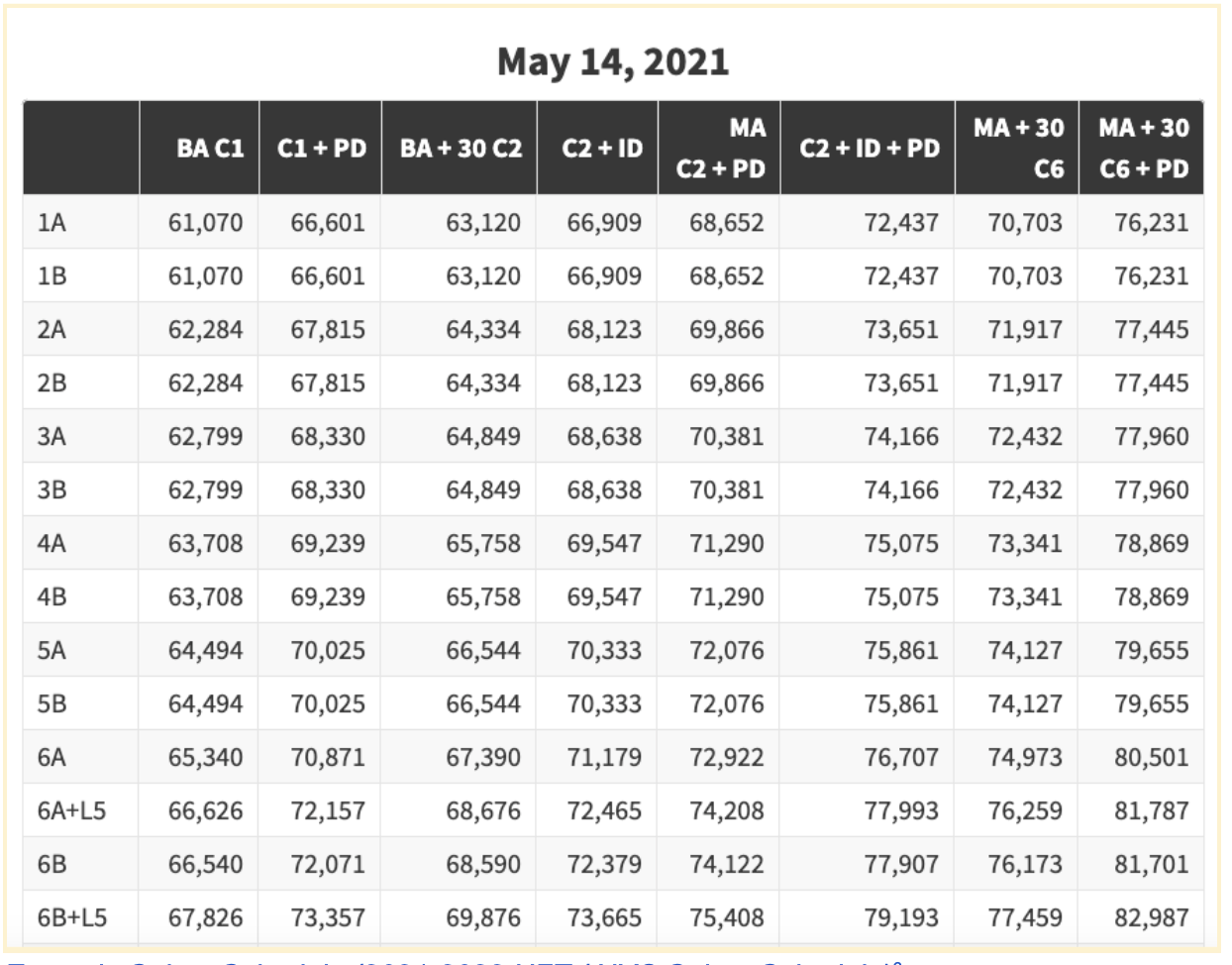How Can Teachers Make More Money?
When teachers enter the profession, they know that they probably won’t make as much
money as their counterparts in finance, law, medicine, or business. In fact, teachers make about 20% less than peers in other industries with the same
level of education1.
But, teachers are generally comforted by a sense of job stability (over time, as compared with other industries), a clear cut annual schedule, and of course, getting to do meaningful work every day. And most teachers gladly trade having to schedule bathroom breaks for not
having to sit at a desk all day!
Teachers who stay in the profession generally do so for those reasons and more — not
because their pay is always commensurate with the job they do.
So, how can teachers stay and grow in the profession and increase their pay?
The Salary Schedule
Every district has a “Teacher Salary Schedule.” A salary schedule is a chart that lays out how much you’ll get paid each year for
a given amount of experience, education, and professional development earned. The United Federation of Teachers (UFT), one of largest unions in the country, defines
a salary step as, “an incremental increase in salary based on previous qualifying
professional experience” — essentially, as you move step by step up the schedule,
your salary increases2.
Your district’s unique salary schedule is negotiated between the district’s union
representatives and administrators and is built into your contract.
Though every teacher has seen their salary schedule, how many know how to use it as
a guide for tactical income growth?

Example Salary Schedule (2021-2022 UFT / NYC Salary Schedule)3
Are You Leaving Money on the Table?
In education, being transparent about income goals is generally taboo. By comparison,
in other industries, salary range is often discussed during the hiring process at
the first interview! But for teachers, salary information is often disclosed as a
perfunctory mention after an offer has been made. While other professionals can “climb
the ladder” by strategically changing roles, positions, or even companies to earn
more income, teachers can simply use the salary schedule as a guide to improve their
teaching practice and tactically increase their income.
Don’t leave that money on the table!
Moving Up the Salary Schedule: All of the Options
Below are five ways that teachers can move up a salary schedule. You’ll notice that some of them would mean leaving the classroom or your district. If you aspire to be an administrator, that is absolutely a path to higher income in education, but if you want to stay in the classroom and in your current school, focus on numbers two and three!
-
Work towards administration
-
Keep teaching!
-
Gain more professional education
-
Move districts
-
Take up stipend work
The Options: Step by Step
-
Work towards administration
In New York state, the average teaching salary is about $85,8894. In the country, the average principal salary is generally over $100,0005. Of course, being an administrator is an intense job, with long hours and lots of responsibility and stakeholders to answer to, so you have to really want to do this job. But if you’re inspired by those prospects, seek out a certificate in school leadership — and go for it! -
Keep teaching!
By remaining in the classroom and continuing to do your work as an educator, you’ll gain credits for experience, and will make incrementally more money. It’s a slow burn, but you will have a little more in your pocket each year! -
Gain more professional education
If you want to stay in the classroom and in your current school, then continuing education is the main lever you have control over. This is also where it can start to feel a little confusing. Here are some options to help clarify:-
- Earn another degree
In New York, all public school teachers must have Bachelor’s Degrees. They must also earn a Master’s degree within three years of entering the profession. When you gain that degree — boom! You’ll move on the salary schedule and earn more money. After that, you can earn more by earning a higher degree, like a Doctorate. This is most likely only worth it if you want that degree for educational purposes and to perhaps use later in your career to gain access to positions outside of the classroom. - Get Post-Graduate Certifications
But there are plenty of post-graduate educational opportunities that aren’t 5-year-long, intensive doctorate programs — phew! Certifications can help you improve and expand your teaching practice, make you eligible for different types of positions in a school, and help you move on the salary schedule. Great examples of these certifications are Teaching English to Speakers of Other Languages (TESOL), Special Education, and Literacy certifications. - Graduate Non-Degree Courses
And then there’s an option to take one or more single graduate courses that are not intended to lead to a degree (“non-matriculating”), but do help you improve your teaching practice and move on the salary schedule. Because different districts accept graduate credits and some accept CTLE credit hours (Continuing Teacher and Leader Education) — the most effective type of graduate courses to invest in offer both graduate credits and CTLE credit hours. If this is your path, make sure to get the course approved by your school administration before taking it; with approval, this type of professional education will help you move on the salary schedule.
- Earn another degree
-
-
This one is simple: If you’re working for a low-paying district and want to make more money, try to get another teaching position at a different, higher-paying district! If this is your move, note that options two, three, and four here will help boost your resume, potentially helping you get noticed and landing you a higher salary when you are hired!
Move districts -
Take up stipend work
Depending on your school, different “extra duties” may or may not pay much. If you are looking for ways to increase your salary and show your commitment to the community, which is often important for folks seeking long-term employment in one district, taking up extra duties can be a good way to accomplish both of those objectives. Coaching, leading clubs or projects, and supervising trips are just some examples of work in schools that is generally supported by a stipend (a little boost to your paycheck!).
What About School-Provided “PD”?
When I was first teaching, I was inundated with to-dos every day. My main focus was to make sure my lesson was ready, my students
were supported and well-managed, and — if I was lucky — to find time to eat lunch.
The word “busy” doesn’t really begin to describe it. So, admittedly, I may have been
less-than-proactive about focusing on how to increase my income.
I knew that professional education was one way to increase my salary, and I knew that
my school provided mandatory professional development weekly. But were my school-mandated PD hours adding up to credits to move up the salary schedule?
No!
Most schools will not take an active part in moving you up the salary schedule. The
PD they provide generally helps you reach the required numbers of hours you need to
maintain your teaching license on an annual basis. Or, it may target an area of need in your building or district.
Generally, school-provided PD will not apply to movement on the salary schedule.
Wait, I Have to Pay to Make More Money?
The salary schedule is based on three things: education, experience, and duties. You can gain experience and duties without spending any more money — but to gain more education, you’ll likely need to pay. You might be thinking, “Wait, I have to pay to make more money?” But in the long run, it is an investment. Not only does continuing education strengthen and deepen your skills as an educator, but paying $5,000 now for three graduate credits that can increase your salary by $5,000 pays off in the (not so) long run. And, your union or school district may reimburse for some portion of your education. Check your contract and work with your union representatives and district administration to find out about programs that may be available to you.
For non-degree graduate courses, seek the best value from a well-reputed institution
(not a random company), and know that the exponential growth over time is worth the
investment. Your income will increase year-to-year, but that’s not all; since your pension is
based on your salary, investing in education to move up the salary schedule will also
increase your income after retirement.
Use Your Teacher Center
Did you know that there are dedicated people in most schools who will help you improve your practice and understand
the salary schedule? These wonderful professionals — who are generally full-time teachers
— are Teacher Center Directors! Some schools don’t have their own centers, but belong to a Consortium (group of
Centers) through which teachers can access support.
CTLC’s very own Susan Kearns taught for 32 years on Long Island and was a Director; she knows that Teacher Centers
can really help teachers. “It’s our job to know what our people need and what our
districts will allow,” Susan says.
Teacher Center Directors can help you understand your contract and guide you towards
professional education opportunities that your district will likely approve. That’s
why universities often partner with Teacher Centers to offer courses directly to teachers.
If you’re unsure whether your school has a Teacher Center, you can:

-
-
-
-
-
-
-
-
-
- Reach out to Susan at CTLC to see if your school is part of consortium (group of Teacher Centers) and how Stony Brook University can support your professional education.
- Check the NYS Teacher Center site.
- Check with your school.
-
-
-
-
-
-
-
-
How Can You Move Up the Salary Schedule This Summer?
If you look back at the options, the most actionable move you can make this summer to move up the salary schedule is to take one or more “non-degree” graduate courses. You’ll expand and improve your teaching practice and gain credits to make more income.
That money is yours to earn – don’t leave it on the table!
Stony Brook University offers online, asynchronous, high-value graduate courses over
the summer through CTLC. You can take one or more, learn knowledge and skills relevant to your curriculum and
pedagogy, and return to work next year with more credits under your belt!
Enroll in CTLC’s continuing education summer courses to earn graduate credits and CTLE credit hours!
Classes begin in June and seats are limited!
References
1 Economic Policy Institute. (2020, September 17). Teacher pay penalty dips but persists in 2019. Economic Policy Institute.
2 United Federation of Teachers. Salary steps. UFT.
3What will my salary be as a full-time teacher? (2021, June 29). TeachNYC.
4 Will, M. (2019, April 30). Which States Have the Highest and Lowest Teacher Salaries? Education Week.
5 National Center for Education Statistics. (n.d.). Average annual salary for school principals. National Center for Education Statistics.
Resources
Best States for Teachers Seeking Financial Independence. (2020, February 24). Educator FI.
Quick Guide: How to Make More Money as an Educator. (2019, September 9). Educator FI.
NYS Teacher Centers.

